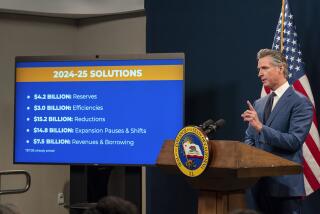Revised California budget plan helps schools and the poor
SACRAMENTO — A growing economy is fueling an expansive plan by Gov. Jerry Brown to provide billions more dollars for schools and a tax break for poor families, even as he accelerates spending to battle the ongoing drought.
In a $169-billion budget plan released Thursday, Brown also proposed setting aside money to provide public healthcare to immigrants who are in the country illegally but would be shielded from deportation under President Obama’s executive action.
The spending plan, more than $4 billion larger than the one Brown proposed in January, calls for a general fund of $115.3 billion — a third higher than the first budget he offered after taking office in 2011.
A final budget is due June 15 and would take effect July 1.
California’s improving fortunes have given the governor a freer hand in managing state finances, although he issued the new plan with his usual cautionary note.
“The state is definitely on the rebound,” he told reporters in the Capitol. “The finances of California have stabilized.”
Still, another recession could be “around the corner,” he warned. “I don’t want to get caught in the jaws of the persistent fiscal instability of the state government of California.’’
In his fourth and final term, the 77-year-old governor is clearly keeping an eye on his fiscal legacy.
“When governors leave town with big deficits, they’re more scorned than praised,” he said.
Higher-than-expected revenue in recent months means schools and community colleges would receive $68.4 billion in the next fiscal year, in accordance with California’s education funding law. Overall, they stand to gain $6 billion more than Brown anticipated in January.
The governor is also making use of new tools and resources provided by voters in November.
A new constitutional amendment requires a yearly deposit in the state’s rainy-day fund. Brown’s plan would stash nearly $1.9 billion in the account, keeping it off the table as he negotiates with lawmakers who want to spend more than he does.
The measure sets aside money for debt repayment and other long-term costs as well. Brown wants to use that to help the University of California pay its pension obligations, satisfying university authorities’ request for more money without dipping deeper into the general fund.
With that provision, Brown was able to reach a deal with UC President Janet Napolitano to avoid tuition hikes for in-state students over the next two years.
Voters also approved $7.5 billion in borrowing for water projects. Funding from it makes up the majority of his $2.2-billion plan to battle the drought.
The governor wants to spend $784 million to prevent or alleviate groundwater contamination, $475 million on water recycling and $180 million to safeguard drinking water in poor communities.
The money, slated to be spent over the next three years, is unlikely to have an immediate effect.
“One of the real challenges ... is having local agencies have the time to prepare quality proposals,” Department of Water Resources Director Mark Cowin said.
Brown also proposes $75 million for financial incentives to get farmers to invest in more efficient irrigation techniques. In addition, there would be $43 million in rebates for residents to replace outdated toilets and appliances and $27 million for those in poor communities to replace thirsty lawns.
Such programs are intended to help the state reduce water use by 25% over the next several months, a target set by the governor in an executive order in April. Democrats in the state Senate last month expressed concern that Brown wasn’t spending enough on conservation programs that could alleviate the drought.
Senate Republican leader Bob Huff (R-Diamond Bar) said more funding may be required in the future.
“We just don’t know where the bottom of this is,” he said.
As in previous years, a major fault line in Brown’s negotiations with lawmakers will be whether the state is doing enough to aid the poor.
The governor, who has faced criticism for not spending more to address poverty, included an earned income tax credit in his budget plan that would allow about 825,000 poor families to keep more of their wages.
The average qualifying household would gain $460 a year. The maximum credit, for families with three or more children, would be $2,653.
“That’s a lot of money when you’re near the bottom,” Brown said.
The credit would reduce state revenue by $380 million, according to administration estimates.
The proposal received bipartisan support, and the governor was praised by Assembly Speaker Toni Atkins (D-San Diego), who said the credit was a priority for her this year.
“It’s really good news for Californians, particularly families that are living on the margins, where this is going to make a significant difference in their lives,” she said.
Brown is also proposing an amnesty program that would help struggling Californians by allowing those with overdue traffic tickets to settle up for half of their penalties, which can range into the hundreds of dollars and carry hefty late fees.
The plan would allow drivers to regain their licenses by agreeing to a payment plan for their tickets, which the governor said would help them escape “a hellhole of desperation.” The proposal would also generate an estimated $150 million in fines that otherwise might go uncollected.
Some lawmakers said Brown wasn’t doing enough. Senate Budget Chairman Mark Leno (D-San Francisco) said he would like to see an additional $500 million to $1 billion allocated to services for the poor.
“There is still a huge need for childcare, for early care and education, for other aspects of our social safety net,” Leno said.
The California Medical Assn. has launched a $10-million advertising campaign to seek higher payments to doctors who serve poor patients through the state’s public healthcare program, Medi-Cal. Payments were cut back during the recession and have not been fully restored.
Enrollment in Medi-Cal has increased under Obama’s federal healthcare law, and advocates for doctors say lower payments make healthcare providers less likely to participate, reducing access for new patients.
Michael Cohen, Brown’s finance director, said the administration did not want a blanket rate increase without knowing that more patients would be treated.
“You actually have to show that you’re serving more people,” he said.
Twitter: @chrismegerian
Times staff writers Melanie Mason, Patrick McGreevy, Matt Stevens and Paige St. John contributed to this report.
More to Read
Sign up for Essential California
The most important California stories and recommendations in your inbox every morning.
You may occasionally receive promotional content from the Los Angeles Times.











